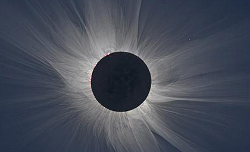 HEAPOW: Corona Light (2017 Aug 21)
HEAPOW: Corona Light (2017 Aug 21)
The crown of the Sun's atmosphere, its outermost region, is called the corona. The corona is extremely hot, with temperatures topping millions of degrees, and streams from just above the visible surface of the Sun outward into space. The corona is very dynamic and changes with the solar sunspot cycle, and on much shorter timescales too. Except for the odd coincidence that the moon and the Sun have the same apparent size as seen from earth (the moon being 400 times smaller than the Sun, but 400 times closer) we would not be able to see the corona from earth, since it is much fainter than the visible emission from the Sun's photosphere. But during total solar eclipses (like the one happening today across the entire U.S.) the moon moves directly between the Sun and Earth, casting a 65-mile wide spot of total darkness on the earth. This black spot moves across the earth at speeds in excess of 1000 miles per hour. If skies are clear, people within that shadow band will be able to see the light from the corona for a brief period (up to a few minutes) when the moon covers the Sun. Understanding the solar corona is important, since it's the one part of the Sun that, in a very real sense, materially touches the earth. Eruptions and explosions powered by the tangling of the Sun's magnetic field are responsible for the corona's extreme temperature, and also can expel large portions of the corona into space during coronal mass ejection events. If the earth is in the path of a CME, charged particles from the CME will interact with the earth's magnetic field, producing colorful aurorae. But very powerful CMEs can damage communication satellites orbiting the earth, and can pose a danger for astronauts on the International Space Station and even airline passengers. Aside from the danger of these events, views of the corona during totality are spectacular. So, if you can, go outside and enjoy the eclipse. But make sure you use proper precautions to view the eclipse safely, since even a small amount of the photospheric light from the Sun can damage your eyes.
NASA Eclipse2017 | Total Solar Eclipse 2017
APOD: Corona from Svalbard (2015 Mar 31)
| << Previous HEAPOW | High Energy Astrophysics Picture of the Week | Next HEAPOW >> |